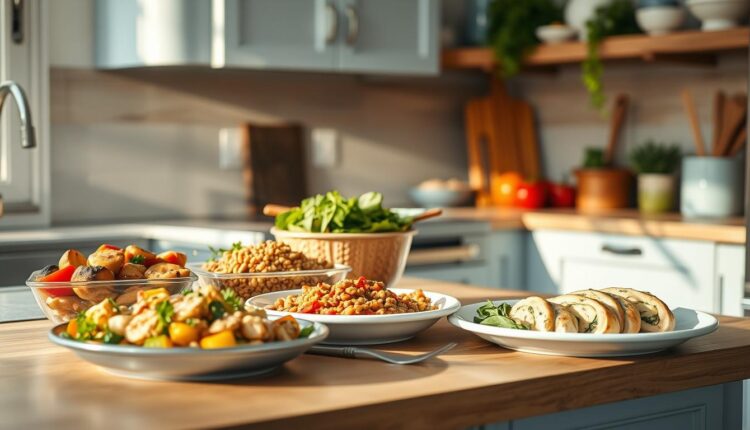High Protein Lunch Prep Italian Recipes Beyond Pasta
Explore high protein lunch prep italian recipes that go beyond pasta. Simple, healthy meal prep ideas for busy lifestyles.
What if your midday meal could fuel your week without relying on the same old noodles? Italian cuisine offers far more than carb-heavy classics – think white bean salads bursting with fresh herbs or baked dishes layered with lean meats and roasted veggies.
This guide is for anyone craving flavor-forward lunches that balance convenience and nutrition. We’ll explore smart ingredient swaps and prep-ahead techniques perfect for tight schedules. From pantry staples to freezer-friendly solutions, these dishes come together faster than boiling water for spaghetti.
You’ll discover how to:
- Use unexpected ingredients like lentils and farro as flavor-packed bases
- Batch-cook versatile proteins that work across multiple meals
- Create balanced plates with bold Mediterranean-inspired flavors
No culinary degree required – just practical strategies for making your kitchen work smarter. Because good food should simplify your week, not complicate it.
Overview of Italian-Inspired High Protein Meal Prep
Italian kitchens have always prioritized satisfaction and sustenance. Think beyond cheese-laden pasta—sun-drenched regions rely on white beans, grilled seafood, and herb-rubbed meats to create dishes that naturally deliver 20+ grams of protein per serving. These staples repair muscles, stabilize energy, and keep you full through afternoon meetings.
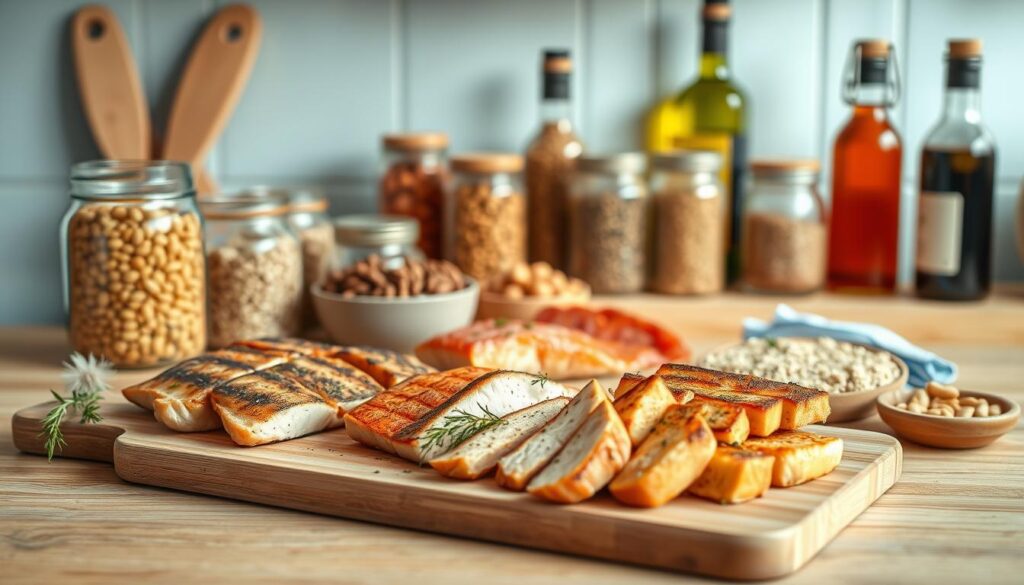
The Protein Advantage in Mediterranean Cooking
I’ve found that traditional Italian meals excel at combining flavor with function. A simple caprese salad becomes protein-packed when layered with fresh mozzarella and basil. Batch-cooked turkey meatballs simmered in marinara? They’re weeknight heroes that freeze beautifully.
Making Meals Work for Your Schedule
Last Tuesday, I prepped grilled chicken cutlets with giardiniera while roasting chickpeas for salads. By Thursday, both starred in wraps and grain bowls. Planning ahead lets you:
- Repurpose proteins across multiple dishes
- Maintain freshness without daily cooking
- Reduce food waste with intentional ingredient use
One reader shared how swapping deli meats for homemade porchetta-style pork tenderloin slices saved her $18 weekly. That’s the magic of adapting classics—you control quality, portions, and your budget.
Batch-cooking proteins helps reduce daily cooking time, preventing burnout and maintaining meal quality throughout the week.
Understanding “high protein lunch prep italian recipes”
What defines a truly satisfying midday meal that keeps you energized? Today’s approach combines traditional flavors with smart nutrition tracking. Dishes now focus on delivering 25-30 grams protein per serving through ingredients like cannellini beans or shredded chicken thighs – not just cheese-heavy classics.
Measuring grams per portion helps balance meals without guesswork. A Tuscan white bean salad with tuna packs 28 grams, while baked eggplant stacks with ricotta hit 22 grams. These numbers guide smarter prep – I once adjusted my meatball recipe after realizing it only provided 18 grams per plate.
| Dish | Key Ingredients | Grams Protein Per Serving |
|---|---|---|
| White Bean & Tuna Salad | Cannellini beans, olive oil-packed tuna | 28g |
| Chicken Cacciatore Bake | Skinless thighs, mushrooms, tomatoes | 34g |
| Lentil Minestrone | French lentils, pancetta, kale | 24g |
Portion control becomes effortless when you know your targets. One reader shared how tracking her servings helped reduce afternoon snacking by 75%. “Seeing the numbers made me realize I wasn’t eating enough at lunch,” she noted.
Three rules I follow:
- Always verify nutrition labels on packaged items
- Use kitchen scales for proteins during prep
- Pair plant-based and animal sources for variety
This method isn’t about strict counting – it’s understanding how components work together. When you grasp what 30 grams looks like in different dishes, building satisfying meals becomes second nature.
Italian Recipes That Go Beyond Traditional Pasta
Italian cooking’s secret weapon isn’t carbs—it’s clever protein pairings. While pasta dishes dominate menus, the real magic happens when you layer bold flavors with smart nutrition. Last week, I transformed a classic Bolognese by swapping regular ground beef for 96% lean and adding lentils. The result? A hearty ragu with 32 grams of protein per bowl.
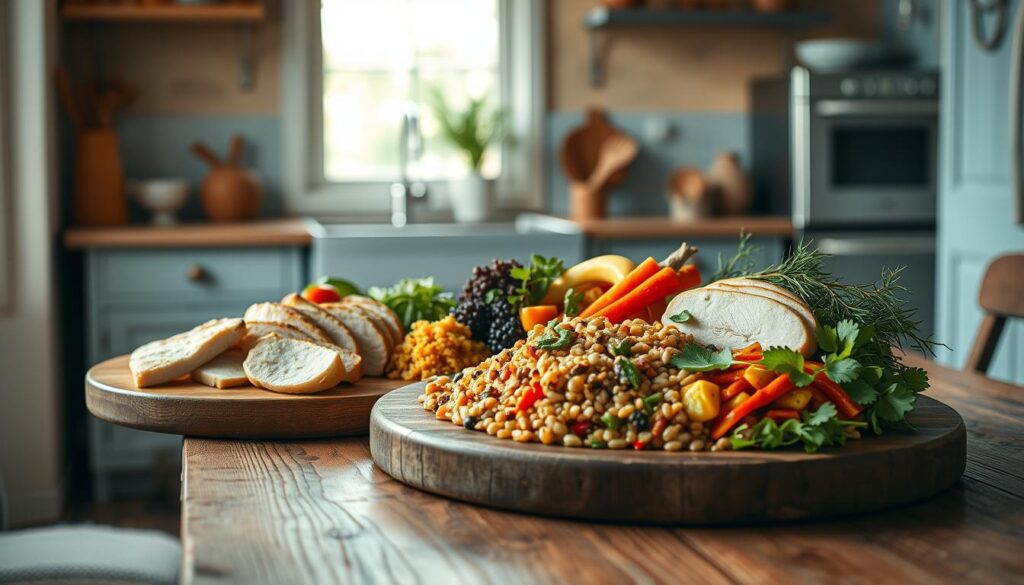
Incorporating Lean Meats and Plant-Based Proteins
Traditional dishes become nutrition powerhouses with simple tweaks. Try chicken scallopini with lemon-caper sauce instead of veal, or stuff portobello mushrooms with herbed turkey sausage. For plant-based options, white beans mimic the creaminess of risotto when blended into a dairy-free base.
Quality ingredients elevate every bite. A reader once shared how using fire-roasted tomatoes in her marinara doubled the depth without added salt. Homemade sauces let you control calories while amplifying flavor—try blending roasted red peppers into Arrabbiata for a vitamin-packed kick.
These adaptations work for diverse diets. A vegan “meatball” sub with lentil-walnut balls and cashew ricotta satisfies cravings while delivering 22 grams of protein. As one home cook noted after trying creative twists, “I didn’t miss the pasta—the textures and spices felt authentically Italian.”
Incorporating Nutrient-Dense Ingredients in Italian Cooking
The secret to vibrant Italian dishes lies not in heavy sauces, but in letting fresh components shine. I learned this during a summer in Tuscany, where sun-ripened produce transformed simple meals into masterpieces. Nutrient-dense choices build flavor and nourishment simultaneously—no compromises needed.

Using Fresh Vegetables, Herbs, and Healthy Fats
Chopped zucchini ribbons or roasted bell peppers add color and texture to baked dishes. Last week, I revived leftover grilled eggplant by tossing it with garlic-infused oil and oregano—it became a star pizza topping. For herbs, tear basil by hand to preserve its oils, and store stems in water like cut flowers.
The Impact of Tomatoes, Basil, and Olive Oil on Flavor
Sun-drenched tomatoes offer natural umami that canned versions can’t match. Pair them with quality oil for dressings that cling to greens without drowning them. A reader once shared her trick: “I drizzle oil over pre-chopped veggies before refrigerating—it locks in freshness and adds richness.”
Three prep strategies I swear by:
- Chop cruciferous vegetables first—they stay crisp longest
- Blanch greens in batches for quick weeknight additions
- Freeze herb-oil cubes for instant flavor boosts
These small steps turn basic ingredients into restaurant-worthy meals. As one home cook noted after trying my marinated artichoke method: “I finally understand why Italian food feels like a hug on a plate.”
Some Mediterranean recipes may contain higher sodium levels, so be mindful of your seasoning and portion control.
Effective Meal Prep Strategies for Italian-Inspired Dishes
Ever opened your fridge to find yesterday’s vibrant flavor bomb now tastes like cardboard? I’ve been there—until I cracked the code on keeping zesty basil dressings bright and roasted veggies crisp through Friday. The secret lies in smart storage paired with intentional layering.

Locking In Freshness Without Losing Zest
Store dressings and sauces separately in small jars—this prevents sogginess while preserving texture. For herb-forward dishes like Italian Chicken Meal Prep Bowls, add fresh basil leaves just before eating. One reader shared, “My tomato-basil quinoa still tastes garden-fresh on day four thanks to this trick!”
Calorie-conscious cooks should measure oils during prep. I use 1 tsp portions in reusable containers—it’s faster than daily logging and keeps meals balanced. For protein-rich mains, weigh portions using a kitchen scale to hit your gram goals without second-guessing.
Streamlining Your Cooking Process
Batch-cook versatile bases like garlicky white beans or lemon-herb chicken on Sundays. These become building blocks for multiple meals—toss beans into salads or blend into soups, while chicken stars in wraps or grain bowls.
Three time-savers I rely on:
- Pre-chop veggies for roasting and snacking
- Portion nuts/seeds into snack bags for added crunch
- Freeze individual servings of soups and stews
“Using these hacks cut my kitchen time by half,” a parent recently told me. By focusing on flexible ingredients and strategic storage, you’ll savor every bite—no culinary burnout required.
Italian Culinary Traditions and Their Health Benefits
Ever wonder how nonna kept her pantry stocked with vibrant flavors year-round? Time-tested preservation methods like pickling transform humble veggies into nutritional powerhouses. Take giardiniera—that tangy mix of cauliflower, carrots, and peppers isn’t just a sandwich topper. It’s a flavor-packed way to add crunch and probiotics to meals while cutting prep time.
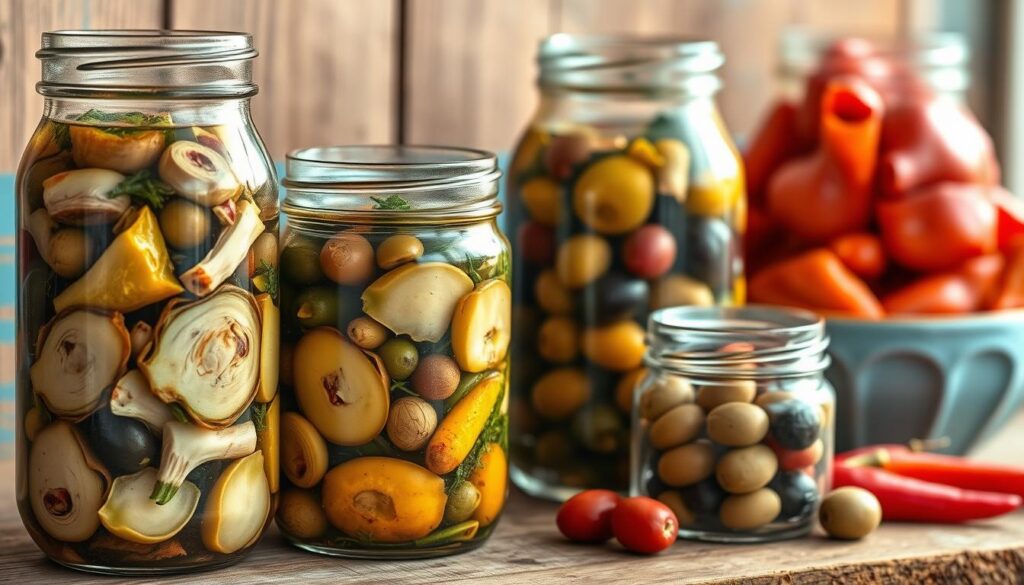
The Role of Giardiniera and Other Pickled Vegetables
Traditional pickling extends freshness from minutes to months without artificial preservatives. A reader once shared how adding giardiniera to her white bean salads kept them crisp for five days—no soggy lunches. “The vinegar acts like a natural barrier against wilting,” she noted.
Modern cooks can adapt these techniques for low-fat options. Swap oil-heavy dressings with pickling brine for bold taste at 25% fewer calories. Try this quick comparison:
| Recipe Type | Key Components | Prep Time | Fat per Serving |
|---|---|---|---|
| Classic Giardiniera | Olive oil, vinegar, veggies | 15 minutes | 8g |
| Modern Version | Apple cider vinegar, no oil | 10 minutes | 1g |
These zesty additions bridge old-world wisdom with today’s needs. I’ve used giardiniera juice to marinate chicken breasts—it tenderizes meat while adding complex flavors in under 30 minutes. One parent told me, “My kids now ask for ‘confetti veggies’ in their wraps instead of ranch dressing.”
Three ways to harness tradition:
- Layer pickled onions into grain bowls for acidity
- Use brine as a base for light vinaigrettes
- Mix chopped giardiniera into tuna salads for crunch
Customizing Recipes to Meet Diverse Dietary Preferences
Ever watched a family member push away a dish because it didn’t fit their needs? I’ve navigated this weekly with my dairy-free sister and carb-conscious partner. The beauty of Mediterranean flavors lies in their adaptability—with smart tweaks, one base recipe can become multiple meals.
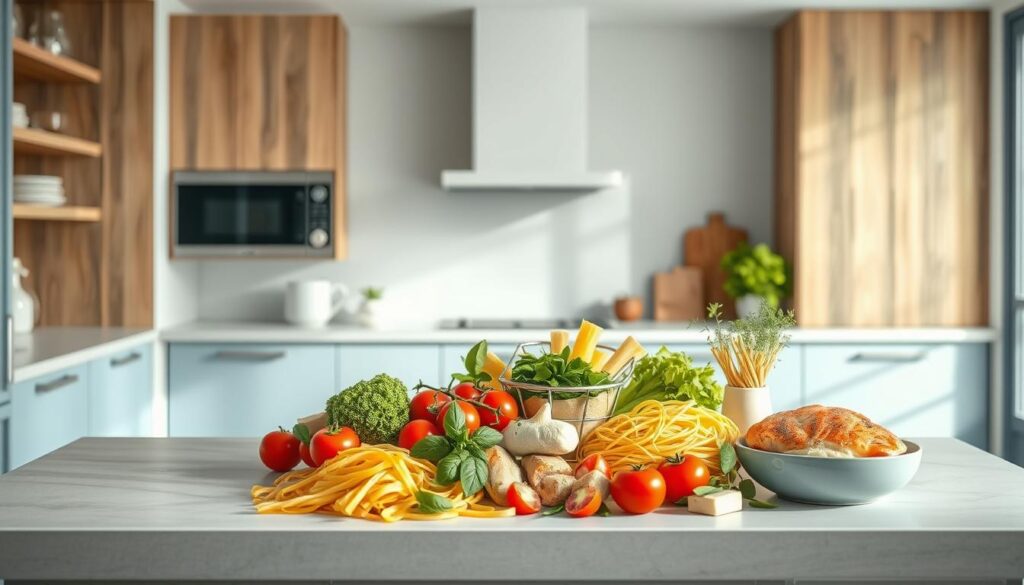
Last month, a reader asked: “How do I keep my grandmother’s lasagna essence without the heavy cheese?” We transformed it using roasted zucchini slices instead of pasta and a cashew-ricotta blend. The result? A lighter version that still earned her nonna’s nod of approval.
Recipe tweaks can make meal prep more nutritious and budget-friendly, helping you hit protein goals effortlessly.
Options for Low-Calorie and Oil-Free Variations
Traditional dishes become diet-friendly without losing soul. Swap olive oil in dressings with lemon juice or balsamic glaze—it adds brightness while cutting 120 calories per serving. For baked dishes, try this comparison:
| Ingredient | Traditional | Light Alternative | Calorie Reduction |
|---|---|---|---|
| Cheese | Whole milk mozzarella | Non-fat ricotta | 45% |
| Dressing | Oil-based | Yogurt-herb blend | 60% |
| Protein | Sausage | Turkey breast | 32% |
Portion control becomes effortless with visual cues. A serving of grains should match your fist size, while proteins align with your palm. For gluten-free needs, roasted chickpeas make excellent crouton substitutes in soups and salads.
Three strategies I use weekly:
- Batch-prep base sauces (marinara, pesto) without oil
- Use vegetable purees to thicken soups instead of cream
- Adjust serving sizes based on activity levels
“Swapping half the cheese for mashed cauliflower in my baked ziti saved 210 calories per portion—my kids didn’t notice!”
These tweaks let you honor tradition while meeting modern needs. Because good food should bring people together—not leave anyone sidelined.
Overconsuming processed oils or cheese can disrupt your nutritional balance, so use them sparingly.
High-Protein Pasta Alternatives in Italian Meal Prep
Who says comfort food can’t pack a nutritional punch? Modern Italian-inspired dishes now embrace pasta alternatives that deliver bold flavors and muscle-fueling benefits. These swaps let you savor every bite while hitting your daily goals.

Legume-Based Noodles: Flavor Meets Function
Chickpea fusilli became my weeknight hero after a reader shared her 15-minute puttanesca hack. With 13g protein per serving, it outshines traditional noodles while holding sauces beautifully. Red lentil penne works similarly—its earthy notes pair perfectly with garlicky mushroom ragù.
Three reasons these alternatives excel:
- Cook 2-3 minutes faster than whole wheat options
- Stay firm for 4 days when stored with sauce separately
- Blend seamlessly into baked casseroles or chilled salads
| Type | Protein per 2oz | Prep Time | Meal Prep Lifespan |
|---|---|---|---|
| Chickpea | 13g | 7-9 mins | 4 days |
| Red Lentil | 14g | 8-10 mins | 5 days |
| Edamame Blend | 24g | 5-7 mins | 3 days |
For time-crunched days, pre-cook batches with olive oil to prevent sticking. One parent told me, “My kids devour the edamame spaghetti with marinara—they think it’s regular pasta!” Pair these noodles with roasted veggies like zucchini or bell peppers for texture contrast.
Pro tip: Add sautéed mushrooms to boost umami without extra salt. Their meaty texture complements plant-based pastas beautifully, creating dishes that satisfy even the most devoted carb lovers.
Boosting Protein Per Serving in Everyday Meals
The easiest way to upgrade your plate starts with what’s already in your pantry. Last week, I transformed a basic minestrone by stirring in two handfuls of cooked lentils—adding 12g protein per bowl without altering the rustic charm. Small swaps create big impacts.
Focus on ingredients that pull double duty. Chickpea flour thickens sauces while contributing 6g protein per tablespoon. A dash of cracked black pepper does more than add heat—it helps your body absorb nutrients from plant-based sources.
Three no-stress strategies I use:
- Mix white beans into tomato sauces for creaminess + 7g protein per ¼ cup
- Top salads with toasted pumpkin seeds (5g protein per ounce)
- Swap breadcrumbs with crushed lupini flakes in meatballs
| Dish | Protein Boost Method | Added Grams |
|---|---|---|
| Vegetable Soup | Lentils + Parmesan rind | 14g |
| Polenta Bake | Greek yogurt instead of cream | 9g |
| Roasted Veggies | Pecorino dusting | 6g |
Fiber-rich additions like artichokes or cannellini beans keep you full longer. A reader recently shared: “Adding ½ cup edamame to my weekly pesto pasta doubled the protein—my kids didn’t notice the green specks!”
Remember: seasoning is your secret weapon. Smoked paprika or red pepper flakes elevate flavors while letting you cut back on salt. These tweaks prove that hitting daily goals doesn’t require overhauling recipes—just smarter ways to use what you love.
Quick and Simple Recipe Ideas for Lunchtime Italian Creations
Time-crunched days demand meals that deliver both speed and satisfaction. My kitchen counter often holds a rainbow of fresh ingredients ready for fast assembly—think juicy tomatoes, fragrant basil, and pantry staples that transform into vibrant dishes. These creations prove that bold flavors don’t require hours of simmering.
Easy Steps to Prepare Flavorful Dishes in Minutes
Start with the Italian Dense Bean Salad: rinse canned cannellini beans, then toss with diced tomatoes, torn basil leaves, and a drizzle of balsamic glaze. Last week, a reader shared her genius addition—cubed mozzarella for creaminess. “It’s like caprese meets Tuscan pantry,” she raved.
For handheld options, try tomato-basil chicken wraps. Spread whipped ricotta on whole-grain tortillas, layer with pre-grilled chicken strips, and top with sliced tomatoes. A sprinkle of fresh basil adds that taste of summer even on busy weekdays. Store components separately for grab-and-go assembly.
Three no-fuss upgrades I love:
- Add sun-dried tomato paste to hummus for a savory dip
- Toss roasted cherry tomatoes into grain bowls
- Infuse olive oil with basil for instant dressing
“These tricks helped me ditch sad desk lunches,” a client recently told me. By focusing on fresh elements and smart additions, you’ll savor every bite without clock-watching. Because good taste should fit your schedule—not the other way around.
In-depth Look at Nutritional Information and Macronutrient Balance
Understanding what’s on your plate transforms how you fuel your day. Let’s dissect three crowd-pleasing dishes to see how they deliver balanced nourishment through smart ingredient choices.
Calories, Protein, Fiber, and Healthy Fats Breakdown
Take my Weeknight Beef & Eggplant Bake: 93% lean ground beef keeps saturated fat low while packing 22g protein per serving. Paired with roasted veggies and measured marinara, it delivers 380 calories with 14g fiber—perfect for post-workout recovery.
| Recipe | Key Components | Calories | Protein | Fiber |
|---|---|---|---|---|
| Tuscan White Bean Salad | Cannellini beans, tuna, olive oil | 420 | 29g | 11g |
| Zucchini Lasagna Rolls | Ground turkey, ricotta, marinara | 335 | 31g | 7g |
| Roasted Veggie Bake | Chickpeas, tomatoes, mozzarella | 285 | 18g | 9g |
Notice how ingredients like marinara sauce add flavor without excess calories—homemade versions use 30% less sugar than store-bought. A reader recently shared: “Tracking my portions using your charts helped me hit my protein goals without feeling restricted.”
Three rules for balanced meals:
- Pair lean proteins with fiber-rich veggies
- Use healthy fats (like olive oil) for satiety
- Adjust sauce portions to control sodium intake
These strategies let you enjoy robust flavors while meeting personal targets. Whether you’re building muscle or maintaining energy, knowing your numbers makes every bite count.
Drawing Inspiration from Italian Meal Prep Champions
True kitchen mastery shines when constraints spark creativity. Take Marco, a firefighter who reworked his grandmother’s pasta dish into a portable bake using chickpea noodles and turkey sausage. His version delivers 34g protein per portion and freezes in single-serving squares. “It’s about honoring tradition while meeting modern needs,” he shared.
Real-Life Recipe Reinventions
Nutrition coach Tom Venuto advocates for strategic swaps: “Replace half the pasta in main dish recipes with spiralized veggies. You’ll keep the heartiness while doubling fiber.” His zucchini-lasagna hybrid uses cottage cheese instead of ricotta, cutting sodium by 40% without sacrificing creaminess.
“The best meals balance nostalgia with nourishment. If you’re looking for weeknight wins, focus on one hero ingredient and build around it.”
Expert-Approved Adaptations
Try these variations from meal prep pros:
- Swap 50% ground beef with lentils in meat sauces
- Use whipped cottage cheese as a low-fat binder in baked dishes
- Pre-cook farro for grain bowls that stay chewy for 5 days
| Traditional Dish | Modern Take | Protein Boost |
|---|---|---|
| Spaghetti Carbonara | Edamame noodles + turkey bacon | +18g |
| Chicken Parmigiana | Almond-crusted cutlets + marinara | +6g |
| Minestrone | White beans + kale + pesto swirl | +12g |
Whether you’re looking for freezer-friendly solutions or fresh twists on classics, these strategies prove that flavorful main dish creations thrive within real-life routines. As one home cook noted: “My family now requests ‘Marco’s bake’ over takeout!”
Conclusion
Who knew honoring grandma’s recipes could also fuel your fitness goals? This journey through Italy’s culinary wisdom proves tradition and nutrition aren’t opposites. Those chickpea noodles you tried last Tuesday? They’re just the beginning.
Let’s recap your kitchen toolkit:
Swap wheat pasta for protein-rich alternatives like edamame blends that keep for days. Batch-cook versatile tomato sauces using fire-roasted veggies for depth without dairy. Remember Sarah’s lasagna hack? Her zucchini-and-cashew version stays true to comfort food roots while cutting calories.
One reader recently shared: “Using chickpea fusilli in my weekly bake saved 20 minutes of prep—my kids think it’s regular pasta!” That’s the magic of smart swaps. They let you maintain flavor while hitting 30-gram protein targets effortlessly.
Ready to make it your own? Try these starter moves:
- Mix sun-dried tomatoes into store-bought marinara for instant umami
- Top lentil penne with roasted mushrooms instead of meat
- Freeze individual sauce portions in muffin tins
Your turn—what twist will you add to these foundations? Share your creations using #PrepistryEats. Let’s build a lunch revolution that respects tradition while rewriting the rules.
High-Protein Creamy Tuscan Chicken Meal Prep
A rich, flavorful dish featuring tender chicken in a creamy sun-dried tomato and spinach sauce, perfect for meal prepping with a high-protein twist.
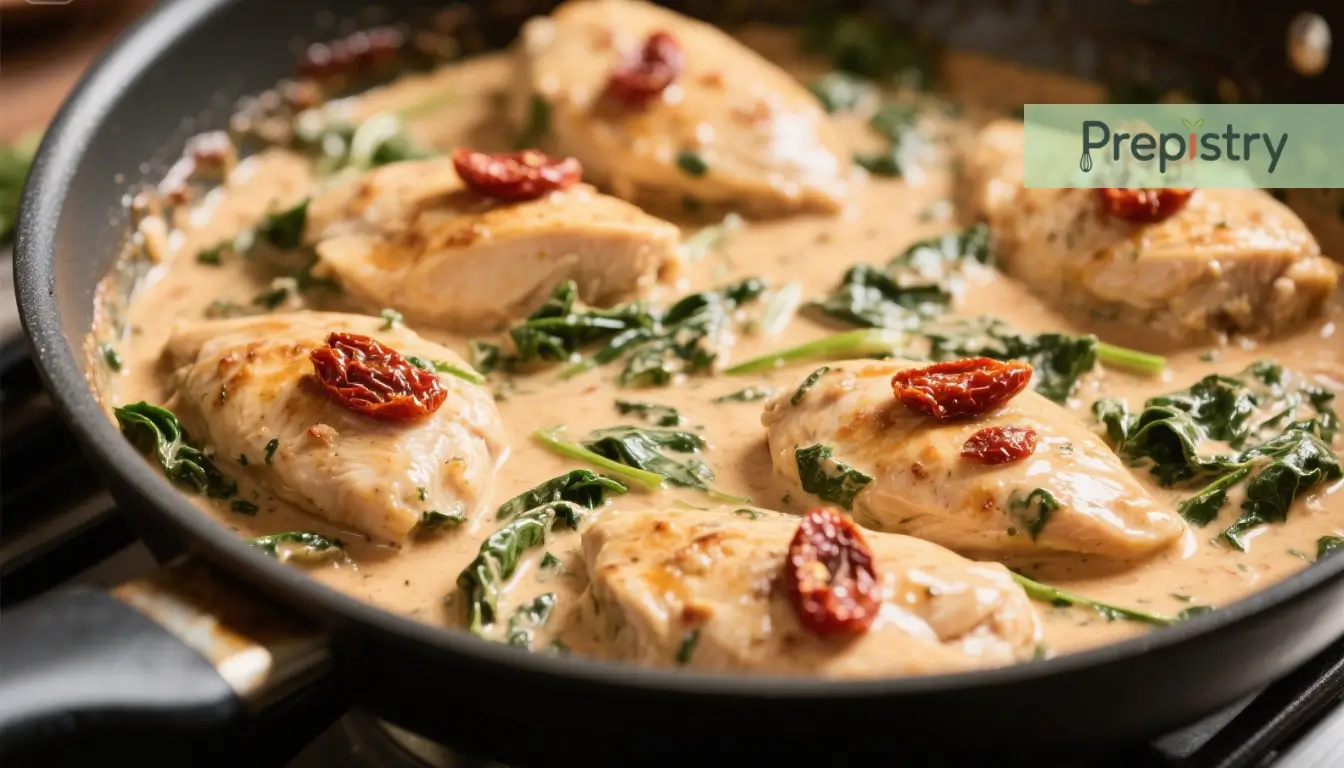
Nutrition Information
Equipment Needed
- Large skillet
- Knife
- Cutting board
- Measuring spoons
- Measuring cups
- Wooden spoon
Ingredients
-
4 large chicken breasts, sliced horizontally to make cutlets
-
2 teaspoons olive oil
-
2 tablespoons butter
-
5 cloves garlic, finely diced
-
1 small yellow onion, diced
-
1/3 cup (80ml) chicken broth
-
5 ounces (150g) jarred sun-dried tomatoes in oil, drained and chopped
-
1 3/4 cups heavy cream
-
Salt and pepper, to taste
-
3 cups baby spinach leaves
-
1/2 cup grated Parmesan cheese
-
1 tablespoon fresh parsley, chopped
-
3 cups steamed cauliflower rice
Instructions
Recipe Video
Healthy Creamy Tuscan Chicken | How to make Tuscan Chicken Recipe? Low Calories, High Protein.
Healthy and Creamy Tuscan Chicken is a low-carb and healthy chicken breast dinner recipe full of flavours. It's so easy to make and bursts with comforting Italian flavours in every bite.

